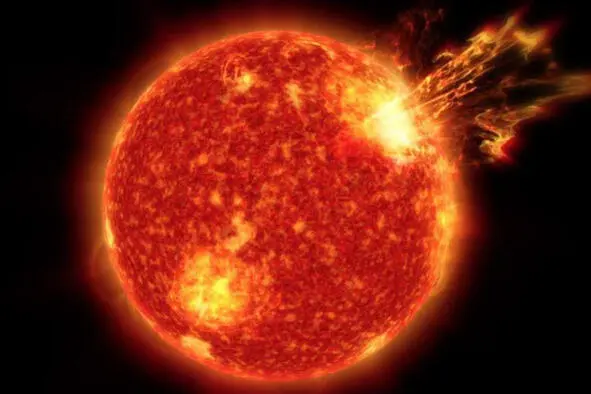Planets and stars
The History of almost Everything
Lim Word
© Lim Word, 2018
ISBN 978-5-4490-9052-2
Created with Ridero smart publishing system
…The author is interested in cooperation with publishing houses in the compilation of the «History of almost Everything» in all fields of science and public life. Please look at my work. Sincerely, wordo-w@mail.ru …Лим Ворд
Demonstration characteristics. The diameter of 109 diameters of the Earth, the gravity at the surface, at the equator 28 earth. The core temperature is 1.5 million degrees, the second is the space velocity of 617 km. from.
Interesting studies of the Sun are conducted by the European apparatus SOlar and Heliospheric Observatory (SOHO), since 1995. In particular, it was this station that discovered exotic objects with the size of a slightly more terrestrial Moon above the North Pole of the Sun. The American STEREO project is also interesting – a bunch of two remote devices forming a stereoscopic image of «our» star.

…The Sun

It’s really hot here…

Emission of matter from the solar corona
The diameter of 4, 9 thousand kilometers, (about 0.4 terrestrial), the period of revolution around its axis 58 earth days. Variations of temperatures on the surface of the planet range from minus 190 C at night to plus 430 degrees during the day. Acceleration of free fall 3.7 m. sq., 2.5 times less than on Earth. The second space velocity is 4.25 km. from.
The equatorial rotation speed is just over 3 m. Thus, here is a note to the science fiction writers, from the onset of a sizzling day, an astronaut can leave at a rapid pace. Further pictures of the planet without comment, for a long psychedelic contemplation.





Acceleration of free fall at the equator (gravity) is 0.9 terrestrial. The period of revolution around its own axis is 225 terrestrial days. The radius is 6052 km. The atmosphere consists almost entirely of carbon dioxide, clouds of sulfuric acid vapor are floating in the atmosphere. Atmospheric pressure is 92 terrestrial. In practice, a gas whose density is equal to 7% of the density of water is already some kind of liquid.
The temperature on the lower surface of such a gaseous ocean is 460 degrees Celsius. The atmosphere of Venus is involved in continuous circular motion. A complete revolution around the planet of a mass of carbon dioxide, at an altitude of 10—50 km. having a speed of about 100 ms. (at the surface – 1 ms) are performed in four days.
In the distant past, perhaps, Venus was quite suitable for inhabiting the known protein forms of life, the heavenly body. The maximum temperature on the surface reached barely 80 degrees Celsius, the atmosphere is rather sparse and transparent. However, a planetary catastrophe – a collision with a large asteroid or comet, perhaps the loss of a huge satellite – become a single planet, Mercury (there is such a version), all this changes. The morning star in one far from perfect moment changes the direction of movement around its axis, enveloped in a dense, corrosive atmosphere. Life, if it has ever been there, ceases.
Everything can be and not so bad. The photographic cameras of the Soviet probe «Venus», which produce images for one and a half hours (while the station was still «living») showed an interesting anomaly. Stones of a characteristic elongated shape, a few minutes after the loud landing of the apparatus, revealed themselves, as if bold oysters of the earth.
Whether this is so, or the appearance of cracks in the stones – a play of light and imagination, will clarify only further instrumental research.
Poetry:
On that faraway star, upon Venus
Where the Sun burns golden and brightly
And on Venus, ah… upon Venus
The blue leaves of trees they waft lightly
(Nikolay Gumilev)

Venus, view of the Earth’s telescope

Venus, the surface according to the infrared spectrometer of the European probe «Galileo».



The surface of Venus (probes «Venus-9» and «Venus-10.»)

The reconstructed image of the surface of Venus
The photographs of the night terrestrial surface from near-earth orbit are presented.



…I suggest you just enjoy these pictures…

…In 1971, the astronauts of the mission «Apollo-14» drop to the moon the take-off stage of the lunar module. The previously installed seismographs record surface oscillations unusually long – about an hour and a half.
Читать дальше






























